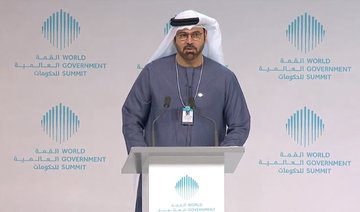DUBAI: Francis Fukuyama, the American political scientist who famously forecast the “end of history,” told the World Government Summit in Dubai that Iran was heading toward a crisis caused by social tensions between generations within the country.
“In Iran. there has been a social revolution going on beneath the surface. There is a young population, well-educated women in particular, who do not correspond to the rural, conservative power structure that runs the country. It’s headed toward some kind of explosion and I’m not sure of the outcome, but it is not a stable situation.”
His warning came during a sobering speech that highlighted many of the challenges facing government and policy-makers, from the weakness of international institutions to the threat of cyber and biological warfare, and the rise of “strongman” leaders in many parts of the world.
Fukuyama said that recent disturbances in Iran were partly because of climate change factors such as drought and water shortage, which often caused violence and cut across all the other risk factors.
“A lot of the recent unrest in Iran had environmental causes. Ground water sources were being overused, leading to drought. A lot of violence in the world is due to climate change,” he said.
There were some positives in an otherwise gloomy analysis of global affairs. In conversation with Anwar Gargash, the UAE minister of foreign affairs, he said that the Gulf states had shown that it was possible to establish credible economic and political models without the influence of Western liberal democratic institutions.
“The Gulf has got the ‘liberal’ part well. It has security and the rule of law and property rights. Maybe the democratic aspect has been shown to be not that necessary.
“The Gulf is showing the rest of the Arab world how to do it. The problem with the Arab world has been not being able to establish stable states. Libya, Iraq, Syria, Yemen are all failed states to some degree or other,” he said.
Fukuyama said that Tunisia, where he has traveled recently, was the only democracy to come out of the Arab Spring upheavals of 2011. “But they are not delivering economic growth. The country will not collapse but it is hanging by a thread.”
He agreed that the US invasion of Iraq in 2003 was the precursor to American disentanglement from the region, and that there was now a serious risk of “big power” confrontation in Syria. The dominance of the US from the fall of the Berlin Wall to the global financial crisis was an anomaly. There has never been a period when one state had so much power. Now the US is not reacting well because it’s used to being in charge.
Fukuyama said that the US was being “displaced” by China, which already has a bigger economy by some measurements. “The global financial crisis discredited the economic systems of the USA and the European Union. The ‘one belt, one road’ policy of China is hugely ambitious, shifting the entire global center of gravity to central Asia with the aim of moving China to a new stage of their national development.”
He said that financial markets were underrating the risk of serious military conflict in Korea. “It could be a replay of the Korean War of the 1950s,” he said.
But he said that the most serious threat to the global liberal order came from within Western countries, where populism, anti-globalization and anti-migration sentiment had led to the rise of a class of “strongman” leaders who were undermining the institutions of their countries.
He said that the “old poles” of capitalism versus communism were dead, but were giving way to “identity politics” — clashes between ethnicities and religions, where compromise was harder to achieve. He said that Islamic terrorism was an example of identity politics.
Iran is heading toward a social explosion, says ‘end of history’ man Fukuyama
Iran is heading toward a social explosion, says ‘end of history’ man Fukuyama

WHO says no medical supplies received in Gaza for 10 days

GENEVA: The World Health Organization said Friday that it has received no medical supplies in the Gaza Strip for 10 days as Israel pursues a new offensive against Hamas.
Israel’s closure of the Rafah crossing into Gaza has caused “a difficult situation,” WHO spokesman Tarik Jasarevic said. “The last medical supplies that we got in Gaza was before May 6.”
Israeli troops entered the city of Rafah on May 7 to extend their offensive against Hamas over the militant group’s attacks seven months earlier. They closed the Rafah crossing into Egypt that is crucial for humanitarian supplies.
With UN agencies warning of a growing risk of famine in Gaza, the Kerem Shalom and Erez crossings from Israel are also virtually shut down.
Jasarevic said the biggest concern was over fuel needed to keep clinics and hospitals running. Gaza’s health facilities need up to 1.8 million liters of fuel a month to keep operating.
The spokesman said only 159,000 liters had entered Rafah since the border closure. “This is clearly not sufficient,” he added, highlighting how only 13 out of 36 hospitals across the Palestinian territory were now “partially” operating.
“Hospitals still functioning are running out of fuel, and that puts so many lives at danger,” said Jasarevic. “Current military operations in Rafah are putting countless lives at risk.”
The Hamas attack on October 7 resulted in the death of more than 1,170 people in Israel, most of them civilians, according to an AFP tally based on official Israeli figures. Out of 252 people taken hostage, 128 are still held inside Gaza, but the army says 38 have died.
More than 35,300 people, mostly civilians, have been killed in the Palestinian territory since the war broke out, according to data provided by the health ministry of Hamas-run Gaza.
Hezbollah uses new weapons in Israel attacks

- The Israeli army said three soldiers were wounded in an attack on Thursday
- Hezbollah has a large arsenal of weapons, that it has expanded significantly in recent years
BEIRUT: Lebanon’s powerful armed group Hezbollah announced on Thursday it had used a drone capable of firing rockets at a military position in one of its latest attacks in northern Israel.
Israel and Hezbollah have been involved in near-daily exchanges of fire since the war between Israel and Hamas broke out on October 7.
Hezbollah announced it had used an “armed attack drone” equipped with two S-5 rockets on a military position in Metula in northern Israel.
The Iran-backed group published a video showing the drone heading toward the position, where tanks were stationed, with the footage showing the moment the two rockets were released followed by the drone exploding.
It was the first time they had announced the use of this type of weapon since the cross-border exchanges with Israel erupted in October.
The Israeli army said three soldiers were wounded in Thursday’s attack.
Hezbollah-affiliated media said that the drone’s warhead consisted of between 25 and 30 kilogrammes (55 and 66 pounds) of high explosive.
Military analyst Khalil Helou told AFP that the use of drones offers Hezbollah the ability to launch the attack from within Israeli territory, as they can fly at low altitudes, evading detection by radar.
Hezbollah also announced on Wednesday that it had launched a strike using “attack drones” on a base west of the northern Israeli town of Tiberias.
That attack was the group’s deepest into Israeli territory since fighting flared, analysts said.
In recent weeks, the Lebanese militant group has announced attacks that it has described as “complex,” using attack drones and missiles to hit military positions, as well as troops and vehicles.
It has also used guided and heavy missiles, such as Iran’s Burkan and Almas missiles, as well as the Jihad Mughniyeh missile, named after a Hezbollah leader killed by Israeli fire in Syria in 2015.
Helou, a retired general, said that depite its new weaponry, Hezbollah still relied primarily on Kornet anti-tank missiles with a range of just five to eight kilometers.
They also use the Konkurs anti-tank missile, which can penetrate Israel’s Iron Dome defense system.
Hezbollah has a large arsenal of weapons, that it has expanded significantly in recent years.
The group has said repeatedly that it has advanced weapons capable of striking deep inside Israeli territory.
Analysts have described the skirmishes between Israel and Hamas as a war of “attrition,” in which each side is testing the other, as well as their own tactics.
Hezbollah has expanded the range of its attacks in response to strikes targeting its munitions and infrastructure, or its military commanders.
One such Israeli strike on Wednesday targeted the village of Brital in Lebanon’s eastern Bekaa Valley, with the Israeli army later announcing it had hit a “terror target related to Hezbollah’s precision missile project.”
Helou said Hezbollah’s targeting of the base near Tiberias and its use of the rocket-equipped drone “can be interpreted as a response to the attack on Brital, but it remains a shy response compared to the group’s capabilities.”
He suggested that the Israeli strike likely hit a depot for Iranian missiles that had not yet been used by Hezbollah.
“Hezbollah does not wish to expand the circle of the conflict,” Helou said.
“What is happening is a war of attrition through which it is trying to distract the Israeli army” from Gaza and seeking to prevent it from “launching a wide-ranging attack on Lebanon.”
US officials held indirect talks with Iran on avoiding regional escalation: report

Two top Biden administration officials held indirect talks with Iranian counterparts this week in an effort to avoid escalating regional attacks, Axios reported on Friday.
The conversations marked the first round of discussions between the US and Iran since January, according to Axios.
One Palestinian killed, eight wounded in Israeli strike on West Bank refugee camp

- Israel has killed more than 35,000 Palestinians, according to Gaza’s Health Ministry
RAMALLAH, West Bank: At least one person was killed and eight wounded on Friday in an Israeli air strike on the Jenin refugee camp in the occupied West Bank, the Palestinian health ministry and Israeli military said.
The Palestinian health ministry said the eight wounded people were in stable condition and receiving treatment at hospitals. Reuters could not immediately confirm their identities.
The Israeli military said a fighter jet conducted the strike, a rarity in the West Bank, where violence had been surging long before the Gaza war.
Residents of the refugee camp said a house was targeted.
The West Bank is among territories Israel occupied in a 1967 Middle East war. Palestinians want it to be the core of an independent Palestinian state.
Trapped US doctors are out of Gaza, White House says

- The Palestinian American Medical Association, a US-based non-profit, reported that its team of 19 health care professionals, including 10 Americans, had been denied exit from Gaza after their two-week mission
- Israel has killed more than 35,000 Palestinians in Gaza, mostly women and children, according to the health ministry in the Hamas-run territory
WASHINGTON: A group of US medical workers left the Gaza Strip after getting stuck at the hospital where they were providing care, the White House said on Friday.
Reports emerged earlier this week of American doctors being unable to leave Gaza after Israel closed the Rafah border crossing, including 10 from the US-based Palestinian American Medical Association, who had intended to leave after a two-week mission at the European Hospital in Khan Younis, a city near Rafah in southern Gaza.
On Friday, 17 American doctors and health care workers, out of a total of 20, got out of Gaza, White House national security spokesperson John Kirby told reporters.
“I can assure you that any of them that wanted to leave are out,” Kirby said.
A State Department spokesperson told Reuters that some of the doctors that had been stuck made their way to safety with assistance from the US Embassy in Jerusalem.
Three of the US doctors chose not to depart Gaza, a source familiar with the situation said, adding that the doctors who stayed behind understood that the US Embassy may not be able to facilitate their departure as it did on Friday.
The Palestinian American Medical Association, a US-based non-profit, reported that its team of 19 health care professionals, including 10 Americans, had been denied exit from Gaza after their two-week mission.
The organization said on social media on Wednesday that it had a more doctors waiting to enter Gaza to replace the workers trying to leave.
Israel seized and closed the Rafah border crossing between Gaza and Egypt on May 7, disrupting a vital route for people and aid into and out of the devastated enclave.
Gaza’s health care system has essentially collapsed since Israel began its military offensive there after the Oct. 7 cross-border attacks by Palestinian Hamas militants on Israelis.
Aid deliveries began arriving at a US-built pier off the Gaza Strip on Friday.
















